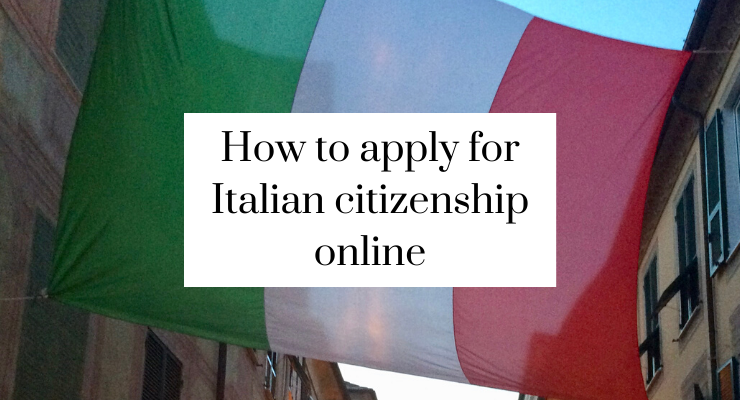So here’s the next instalment in the story of our family journey to become both Italian* and British – and it’s a bit of an exciting one because it includes the moment when I ACTUALLY SUBMIT MY APPLICATION! But there’s a lot of tedious admin stuff to get through before that point – sorry about that. In case you’re wondering why we’re applying for Italian citizenship, it’s because of Brexit – you can read the first part of the story here. Basically, my husband’s family are Italian but he was born in London, so he’s both British and Italian. This means that, hopefully, our kids and I, who were all born in England and are all British, can also become Italian – as long as we can navigate our way through the long and complicated application process. I’ve been sharing our experience of applying for Italian citizenship, step-by-step, in order to help other people who are going through the same thing*.

UK Criminal Records Certificate
When I wrote my previous post about this I’d just applied for a certificate from the police to show that I don’t have a criminal record. This certificate arrived two weeks after I applied for it. I then had to apply via the FCO website to have the Police Certificate legalised (the link for that is here), at a cost of £35.50. The legalised certificate arrived by post a week later.
Translations
I then sent the legalised Police Certificate and my birth certificate (not the original, but a copy that I’d ordered from the General Register Office) to the same translator that I’d used previously (Gabriella Barra – from the London Italian Consulate list of approved translators) for certified Italian translations. The fee for this work was £70. I received the certified translations by post four days later.
Receipt for 250 euros
At this point I thought that I had everything that I needed in order to submit my application for citizenship. But when I checked the London Italian Consulate website I saw that there was (so I thought, although there were actually a couple more unseen hurdles ahead) one more tricky thing that I needed to work out how to provide. I had to pay the 250 euro application fee by bank transfer, which sounds straightforward. But the complicated bit was that I had to get an extremely detailed receipt for this transfer. The receipt had to include the following information:
Beneficiary Account Name: “MINISTERO DELL’INTERNO D.L.C.I. – CITTADINANZA”; address: Via Cavour 6, 00184 ROMA
– Reason for payment: Citizenship Application name and surname of the applicant;
– International Bank Account Number (IBAN code): IT54D0760103200000000809020;
– Receiving Bank Name: POSTE ITALIANE S.P.A.
– Receiving Bank BIC/SWIFT code: BPPIITRRXXX.
I tried to make the transfer using my online banking app, but it was impossible for me to enter the necessary information to generate the required receipt. So then I called my bank, but they were also unable to create a receipt as specified. So I then drove to my bank’s nearest branch, 13 miles away, to see if they could help. Luckily the very helpful and patient staff there figured out a way to generate a receipt with all the required payment details. So that was a relief.
Single PDF file
I now had to scan all of the required documents and create a single PDF file with them, so that I could upload everything easily with my application. I hadn’t combined documents in this way before, but I searched on Google and eventually managed to put everything into one PDF (I have a Macbook and followed this advice from Apple on how to do it).
Submitting the application
Feeling that I had everything ready, at long, long last, I went to the Italian Ministero dell’Interno government website to submit my application. This website is in Italian. The process started off OK, and I was methodically and carefully entering my details, but then I was asked to enter the details of my PEC.
PEC
I’d not heard the term PEC before and I had no idea what it was, but I couldn’t continue with the application without one, so it seemed pretty important. I messaged a very helpful friend in Italy to ask her and she told me that a PEC is a secure electronic mailbox. She said that I could create one for myself through PEC Legalmail. I went to this website (which is all in Italian) and followed the steps to create my own PEC secure email address. However, in order to activate this email address I needed an Italian tax code.
Tax code
This step made me panic initially, as I had no idea how to get an Italian tax code as I live and work in the UK. I asked my friend in Italy, but she didn’t know how I could do it. I then found this Tax Code section on the London Italian Consulate website, which explains how private individuals can apply for an Italian tax code, free of charge, online. All that was needed for this application were copies of my current passport and proof of address. So I followed the instructions and applied through here. I received confirmation of the application straightaway, with an estimated wait of four to six weeks to receive a tax code. In fact, I received my Italian tax code after just 10 days.
PEC activation
Now that I had a tax code, I was able to activate my PEC secure mailbox, which I did.
Applying for Italian citizenship
Finally, a year and a half after starting on this journey, I was able to submit my application for Italian citizenship. I’ve been told that it may take around four years from this point for my application to be processed.
What about the kids?
Our daughter’s and son’s applications are with the Italian authorities, and we’ve been told that it could take up to two years for them to be processed. So far we’ve been waiting for a year for my daughter and 16 months for my son.
Previously…
The previous parts of this story are here:
The one where I decide to apply for Italian citizenship
Applying for Italian citizenship – part 2
Applying for Italian citizenship – part 3
Applying for Italian citizenship – part 4
Applying for Italian citizenship – part 5
Applying for Italian citizenship – part 6
Applying for Italian citizenship – part 7
And here’s a summary of all of the posts:
How to apply for Italian citizenship: everything we’ve done so far
Over to you
If you’d like to share your own experiences of applying for citizenship of another country, or if you have any comments or queries about these posts, please do add to the comments section below. Many people have been contacting me about what we’re doing, and it’s really interesting to hear about your experiences. Good luck to anyone else who’s going through the process, and I’ll keep you posted on how we get on!
* I’m sharing the detail of this journey in order to be helpful, but I’ve not been through a process like this before and I have no legal training, so please do not rely on my experience for your own application.


I am a uk citizen, and am just starting the process of applying for dual citizenship jure sanguinis (my mother was italian – sicilian to be precise). I love the place with all my heart and have a home in sicily BUT your tale illustrates, for me, the absolute disaster zone of italian bureaucracy. I have travelled all over the world on business and been frequently told “ah ….. the british …. you are all rules and forms and regulations !”. I am afraid we are but amateurs compared to this. Incidentally when buying our house in sicily, the process and specifically the role of the notaio, so infuriated and angered me, that I very seriously researched the possibility of relaxation of the rules to allow a modernised procedure that took advantage of modern digital technologies. I quickly concluded that invested interests meant that nothing could possibly ever change. So, as in all things in life, “you pays your money and you makes your choices”. Good Luck and keep the blog going, it has been incredibly useful and informative for me.
Thank you, and good luck to you too. I’m still waiting for a response to my application, I’m not sure if it will ever go through….
Hi Gretta
My wife is at the stage of completing her electronic application for citizenship. At the very end of the application they ask for an “imposta di bollo” of €16, and to let them have details of the “estremi della marca da bollo telematica”, as well as the date of payment.
Having paid the fee of €250 and received a detailed receipt from our bank we thought we were home and dry, but are now stumped by this last requirement. Can you offer an insights?
Thank you
Hi Rocco, I didn’t have to do this, but if you look at the comment from Alan Lomas on this post, he explains what he had to do – hopefully this will help you: https://wp.me/p2dfvd-45u
Glad to find your site. We also live in the UK and My kids and I have our Italian passports but we applied for my husband oct’18 just before the B1 law went into effect. (He’s so lucky). Just to confirm we are also still waiting for his confirmation- I was told to expect 4-5yr but I assume could be longer now due to brexit and covid.
Thanks Stacy, I’m still waiting for mine too!
Holy cannoli. He just got a message today that he will have his citizenship meeting in jan!
That’s great news!
Hi Gretta, Thanks for giving us all this info. My wife is Italian and I started the thing in 2016 after the Brexit vote, but kind of let it lapse. Which was dumb because then the language requirement kicked in. We’ve registered our marriage with the local Italian authorities, and our son now has an Italian passport. But I will have to start all over again, I think.
Your blog is going to be very helpful….
Thanks Richard, I hope that it is helpful, and good luck with your application.
Gretta, your posts are extremely helpful, thank-you very much indeed. I certainly wouldn’t have known about the PEC & the tax code!
I’m applying like you for citizenship via marriage, with the difference that my British wife has only just obtained her Italian citizenship (thanks to Italian grandparents). Also, I have lived in France recently, so need to get a criminal records check from that country too.
I’m using this page on the Consulate website:
http://conslondra.esteri.it/consolato_londra/en/i_servizi/per_i_cittadini/cittadinanza/cittadinanzamatrimonio.html
There are 2 documents listed here I’m still unsure about:
1) CERTIFICATE OF NO CRIMINAL RECORDS
This is in addition to the “Police certificate for immigration purposes” you mention, and I wonder if it’s the UK DBS certificate here:
https://www.gov.uk/request-copy-criminal-record
Do you have a view on this?
2) VALID APPLICANT’S UK RESIDENT PERMIT issued by the UK Home Office
This seems an odd one for someone UK born & bred, but there’s nothing about it being just for non UK citizens. Again, I’d be grateful to know what your experience of this one was.
Thanks again
Kind regards
Alan
Hi Alan, I’m still waiting for my application to be processed, so please don’t take my word for this, but as far as I understand it 1) the ‘certificate of no criminal records’ is the same as the ‘police certificate for immigration purposes’ and 2) the UK resident permit doesn’t exist if you are born in the UK and are British and have always lived here.
That would certainly be logincal, thank-you.
Will continue to follow your progress with great interest
I love reading your updates, Gretta. I am in almost identical situation.
I’m English; my wife is Italian (but has a UK passport through our marriage).
We’ve already registered our marraige with the commune in Italy.
Like you, we have 2 children (one adopted; one not). All 3 of us are at various stages of applying for Italian citizenship through the Consolate in London.
Last week, we received news that both daughters are now registered with Aire and are Italian citizens. Now we need to apply for Italian passports for both daughters (one is under 12 so will be done by post; one is over 12 so we have to prepare for battle with the online booking system…)
As for me, my application was rejected in August 2019 after I submitted it in April 2017. One of the rookie errors I believe was me not putting my middle name (which appears in my UK passport) on the Italian Citizenship paperwork where it said, “Nome”. It looks like I need to start my application all over again and lose the 3 years it’s already taken me (not to mention all the lost costs).
Anyway, your blog put a smile on my face and boosted me with a little confidence that I’m not alone in this!
Hi Giles, thank you, it’s good to hear that the posts are helping. It’s great that your daughters are registered, congratulations. I’m very sorry about your application. I’m kind of expecting that to happen to me. It feels like I’ve launched my application and documents into a void!
Hello Giles, They have registered your daughters and would have seen your Marriage Certificate? I do not believe they would reject your application for your error of leaving off your middle name but ask you to amend your application.
I have been working on this for four years now, almost done with completing my application!
Your is by far the best, most detailed and interesting documentation of your journey!
I have one question–how did you figure out how to upload your files? I was able to select the files, and they are in the required PDF or JPEG files. but when I hit upload they are always rejected.
Any advice is greatly appreciated!
Thank you Leslie, I’m glad that my posts are helpful. I combined the documents into one, single PDF file and uploaded it. Have you tried creating a single PDF with all of your files combined? I hope that you can make it work – it’s all too complicated!
I have recently applied for and received an Irish passport – it took just under a year as I also needed to get a foreign-born certificate. I thought it was quite an onerous and form-ticking process, but compared to your Italian experience it was easy. My tip is to just set aside 10 mins every now and then to try and tackle this sort of bureaucratic procedure. I was dreading it, and yet managed it. And now I’m very happy! Good luck with your Italian intentions.
nicola recently posted…Talal Karim: Finsbury Park Trust
Congratulations, that’s great news! Yes, the Italian application has been very complicated. But now, hopefully, we just have to wait.
I feel tired just reading this very complex procedure (s}. Well done for being so persistent. I do think many people would just give up or not be able to afford the costly fees
The good thing about the costs is that they’ve been very spread out. The biggest cost so far has been the 300 euros we had to pay for our daughter’s application – but we wouldn’t have had to pay that if we’d done it before she was 18!